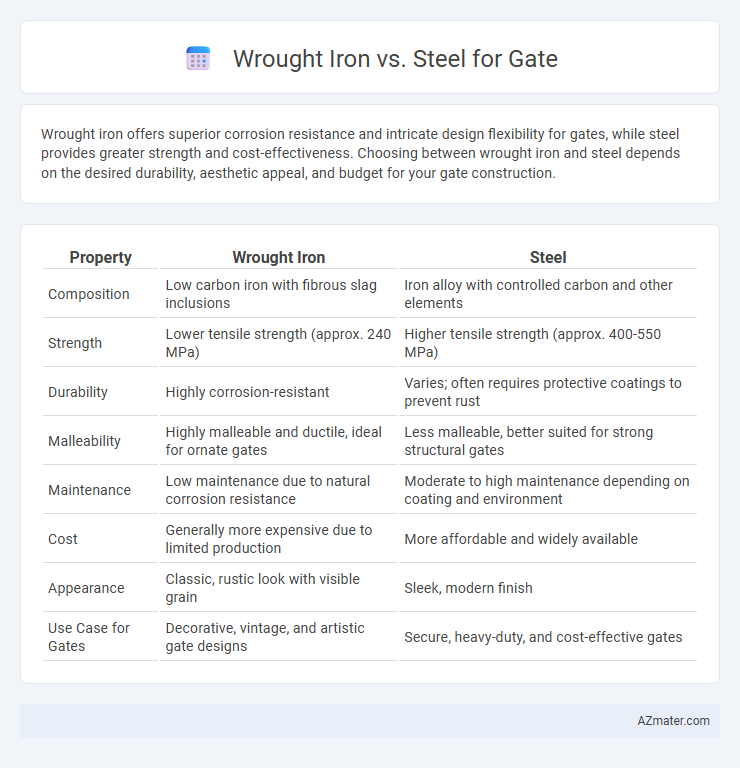Wrought iron offers superior corrosion resistance and intricate design flexibility for gates, while steel provides greater strength and cost-effectiveness. Choosing between wrought iron and steel depends on the desired durability, aesthetic appeal, and budget for your gate construction.
Table of Comparison
| Property | Wrought Iron | Steel |
|---|---|---|
| Composition | Low carbon iron with fibrous slag inclusions | Iron alloy with controlled carbon and other elements |
| Strength | Lower tensile strength (approx. 240 MPa) | Higher tensile strength (approx. 400-550 MPa) |
| Durability | Highly corrosion-resistant | Varies; often requires protective coatings to prevent rust |
| Malleability | Highly malleable and ductile, ideal for ornate gates | Less malleable, better suited for strong structural gates |
| Maintenance | Low maintenance due to natural corrosion resistance | Moderate to high maintenance depending on coating and environment |
| Cost | Generally more expensive due to limited production | More affordable and widely available |
| Appearance | Classic, rustic look with visible grain | Sleek, modern finish |
| Use Case for Gates | Decorative, vintage, and artistic gate designs | Secure, heavy-duty, and cost-effective gates |
Introduction to Wrought Iron and Steel Gates
Wrought iron gates are renowned for their intricate designs, high malleability, and excellent corrosion resistance, making them a classic choice for decorative and durable entrances. Steel gates offer superior strength, lower cost, and enhanced security, often preferred for modern, heavy-duty applications. Both materials provide unique benefits, with wrought iron emphasizing ornamental appeal and steel focusing on robustness and affordability.
Material Composition: Wrought Iron vs Steel
Wrought iron consists primarily of iron with very low carbon content, usually less than 0.08%, making it highly malleable and resistant to corrosion due to its fibrous slag inclusions. Steel, an alloy of iron and carbon typically containing 0.2% to 2.1% carbon, offers greater strength and hardness but is more prone to rust without protective coatings. The differing carbon content and microstructures in wrought iron versus steel directly impact their durability and maintenance requirements for gate construction.
Strength and Durability Comparison
Wrought iron gates offer excellent tensile strength and resist deformation, making them highly durable for long-term use. Steel gates, especially those made from galvanized or stainless steel, provide superior strength with enhanced resistance to corrosion and environmental wear. Comparing both, steel gates generally require less maintenance and offer greater longevity in harsh weather conditions, while wrought iron gates deliver classic aesthetic appeal with robust structural integrity.
Aesthetic Appeal and Design Options
Wrought iron gates offer intricate, ornamental designs with a classic, timeless aesthetic that enhances curb appeal and complements traditional architecture. Steel gates provide greater versatility in design, allowing for sleek, modern lines and customizable patterns through advanced fabrication techniques. Both materials support diverse finishes and colors, but wrought iron emphasizes detailed craftsmanship, while steel excels in contemporary, minimalist styles.
Resistance to Rust and Corrosion
Wrought iron gates exhibit exceptional resistance to rust and corrosion due to their high purity and dense fibrous structure, making them highly durable in outdoor environments. Steel gates, especially when galvanized or coated, offer strong rust resistance but generally require more frequent maintenance to prevent corrosion over time. Choosing wrought iron ensures longer-lasting protection against elements, while steel provides a cost-effective alternative with moderate resistance depending on surface treatment.
Maintenance Requirements and Longevity
Wrought iron gates require regular maintenance, including rust prevention treatments and periodic repainting, to protect against corrosion and ensure durability. Steel gates, while generally more resistant to rust due to galvanization or powder coating, still need occasional inspections and touch-ups to maintain their protective layers. Both materials offer long-lasting strength, but wrought iron demands more frequent upkeep to preserve its classic appearance and structural integrity.
Cost Considerations for Gates
Wrought iron gates typically have higher upfront costs due to labor-intensive forging processes and intricate designs, while steel gates offer more affordable options with mass production benefits. Maintenance expenses for wrought iron can add to long-term costs because of its susceptibility to rust without proper coatings, whereas galvanized or stainless steel gates provide better corrosion resistance and lower upkeep costs. Budget-conscious gate buyers often prefer steel for cost efficiency but may invest in wrought iron gates for their aesthetic appeal and traditional craftsmanship despite the higher price.
Security Features of Each Material
Wrought iron gates offer superior strength due to their dense, malleable composition, making them highly resistant to impact and forced entry, which enhances security. Steel gates provide excellent durability and rigidity, with the ability to be galvanized or coated to prevent rust, ensuring long-term protection against tampering and environmental damage. Both materials allow for intricate designs without compromising security, but steel's higher tensile strength often results in a tougher barrier against potential intruders.
Environmental Impact and Sustainability
Wrought iron gates are valued for their durability and recyclability, contributing to lower environmental impact due to the material's long lifespan and ability to be reforged multiple times without significant loss of quality. Steel gates, although often more affordable and available in various alloys, generally require more energy-intensive production processes and can have a higher carbon footprint, but advancements in recycling steel have improved its sustainability profile. Choosing wrought iron or steel for gates depends on balancing initial environmental costs with long-term sustainability benefits, including maintenance requirements and recyclability.
Choosing the Right Material for Your Gate
Wrought iron offers classic elegance and excellent corrosion resistance, making it ideal for ornamental gates that require intricate designs and long-lasting durability. Steel provides superior strength and cost-effectiveness, suitable for security-focused gates that demand robustness and low maintenance. Selecting the right material depends on balancing aesthetic preferences, budget, and required gate strength to ensure optimal functionality and longevity.

Infographic: Wrought iron vs Steel for Gate
 azmater.com
azmater.com